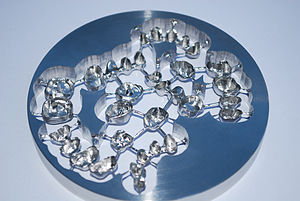CAD/CAM dentistry

CAD/CAM dentistry (Computer-Aided Design and Computer-Aided Manufacturing in dentistry), is a field of dentistry using CAD or CAM technology to provide a range of dental restorations including: crowns, crown lays, veneers, inlays and onlays, fixed bridges, dental implant restorations and orthodontic appliances.
History
Although CAD/CAM dentistry was used in the mid-1980s, early efforts were considered a cumbersome novelty, requiring an inordinate amount of time to produce a viable product. This inefficiency prevented its use within dental offices and limited it to dental laboratories. As adjunctive techniques, software, and materials improved, CAD/CAM use within dental practices increased.[1]
Difference from conventional restoration
"Chair side" CAD/CAM restoration differs from conventional dentistry in that the prosthesis is typically luted or bonded the same day. Conventional prosthesis, such as crowns, have temporaries placed from one to several weeks while a dental laboratory or in house dental lab produces the restoration.[2] The patient returns later to have the temporaries removed and the laboratory-made crown cemented or bonded in place. An in-house CAD/CAM system enables the dentist to create a finished inlay in as little as an hour in some cases.[3] CAD/CAM restorations are also more conservative in their preparation of the tooth. As bonding is more effective on tooth enamel than the underlying dentin, care is taken not to remove the enamel layer.
Process
Typically CAD/CAM dental restorations are milled from solid blocks of ceramic or composite resin that closely match the basic shade of the restored tooth. Metal alloys may also be milled or digitally produced.
After decayed or broken areas of the tooth are corrected by the dentist, an image (scan) is taken of the prepared tooth and the surrounding teeth. This image, called a digital impression, draws the data into a computer. Proprietary software then creates a replacement part for the missing areas of the tooth, creating a virtual restoration. This is called reverse engineering. The software sends this virtual data to a milling machine where the replacement part is carved out of a solid block of ceramic or composite resin. Stains and glazes are fired to the surfaces of the milled ceramic crown or bridge to correct the otherwise monochromatic appearance of the restoration. The restoration is then adjusted in the patient’s mouth and cemented or bonded in place.
Drawbacks
As machine-built substitutes, CAD/CAM treatments have some aesthetic drawbacks, whether they are created at the dental practice or outsourced to a dental laboratory fabricating service. Because the superficial layers are typically 60 to 100 micrometersin thickness, they are not comparable to traditionally fabricated dental restorations, which have multiple layers that are are between 25 to 50 micrometers thick. Likewise, they rely on superficial staining to achieve a more natural appearance, unlike hand-layered porcelain restorations, which possess a deep-set coloration due to the multi-layering. However, traditional restorations also vary in asethetic value. In some hand-layered crowns and bridges, feldspathic porcelain is fused to glass-infiltrated aluminum-oxide or zirconium-oxide, an alumina or zirconium based substructure, creating a high-strength, highly aesthetic, metal-free crown or bridge. In other traditional restorations, this porcelain is layered onto a metal substructure and often display color brightness, an opaque "headlight", and dark oxide lines, a "black line", in the vicinity of the gum line. As these dark metal substructures are not conducive to a natural appearance, metal-free restorations are typically more aesthetically pleasing to the patient.[4]
There are also different medical repercussions for each restoration technique. If the CAD/CAM restorative material is zirconium-oxide (zirconia), the restoration becomes "radio-opaque", just as metal restorations are, blocking x-rays. Only alumina, lithium disilicate and some composite resin materials are "radio-lucent", allowing dentists to track potential decay. Zirconia, conventional porcelain-to-metal, and traditional gold or porcelain-fused-to-metal (PFM) crowns block x-ray radiation, disallowing evaluation over time.
Finally, the accuracy of restorations using CAD/CAM technology is not as consistent as in other dental fabricating processes. Crowns and bridges require an extremely precise fit on tooth abutments or stumps. Scanning and mathematically calculating the stump surface typography has accuracy limitations, as does milling by computer-numeric-control (CNC) machines, however the scanning and milling accuracy has increased substantially since this article was written. Current standards require an accuracy of fit less than 10 microns, meaning the deviation from "perfect fit" is less than 10/1000ths of a millimeter. Currently there is no hand made product that can achieve this kind of accuracy without CADCAM assistance in the manufacturing process.
List of CAD/CAM dental software products
- CEREC, software for manufacturing crowns, veneers, onlays and inlays using different types of ceramic material.
- Delcam dental solutions, for the design and manufacture of copings and bridge frameworks, including full crowns, abutments, dental bars, inlays and onlays, and implant bridges.
- Renishaw plc CAD/CAM systems, from a company that started in industrial metrology with patented probes.
- WorkNC Dental from Sescoi, CAD/CAM for automatic machining of prosthetic appliances, implants, bridges or dental structures.[5]
References
- ^ Miyazaki, T., Hotta, Y., Kunii, J., Kuriyama, S., Tamaki, Y. (2009). "A review of dental CAD/CAM: current status and future perspectives from 20 years of experience". Dent Mater Journal. 28 (1): 44–56. PMID 19280967.
{{cite journal}}: Unknown parameter|month=ignored (help)CS1 maint: multiple names: authors list (link) - ^ Masek, R. (2005). "Margin isolation for optical impressions and adhesion". International Journal of Computer Dentistry. 8 (1): 69–76. PMID 15892526.
{{cite journal}}: Unknown parameter|month=ignored (help) - ^ Sidekick Magazine, “CAD/CAM Technology: You Can’t Afford NOT to Have It”
- ^ Masek, R. (1999). "Reproducing natural color effects on milled ceramic restorations". International Journal of Computer Dentistry. 2 (3): 209–17. PMID 11351485.
{{cite journal}}: Unknown parameter|month=ignored (help) - ^ Micro Manufacturing Magazine, “Dental 3- to 5-axis CAM Software”
